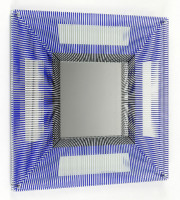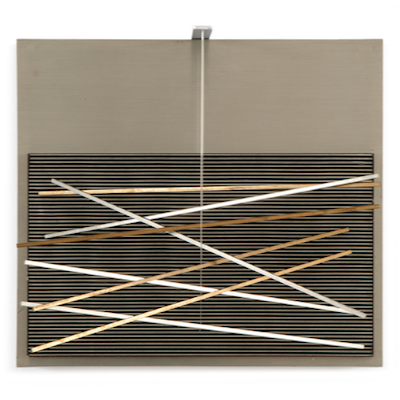
Details
Artist
Styles
Sculpture in Plexiglass with movable part. This work is recto-verso and has 6 different colored circle-combinations. // Chromointerference Manipulable Caribe by Carlos Cruz-Diez, originally conceptualized in 1965 and realized in this edition in 2014, is a dynamic sculpture that utilizes Plexiglass and optical effects to explore color and movement. This artwork features multiple layers of vertical colored lines within a Plexiglass frame, creating an ever-changing pattern of circles in vibrant hues. With a recto-verso design, the piece includes six different color combinations that transform based on the viewer’s angle and interaction. This movable part allows viewers to actively engage with the work, altering their perception of color and form as they shift their position. Measuring 40 x 35 x 10 cm and part of a limited edition of 99 pieces, each signed by the artist, this work captures Cruz-Diez's exploration of color as a participatory experience, integral to his contributions to kinetic art.
Chromointerference Manipulable Caribe, 1965 - 2014
form
Medium
Size
40 x 35 X 10 cm
- Inches
- Centimeters
Edition
Price
- USD
- EUR
- GBP
Details
Artist
Styles
Sculpture in Plexiglass with movable part. This work is recto-verso and has 6 different colored circle-combinations. // Chromointerference Manipulable Caribe by Carlos Cruz-Diez, originally conceptualized in 1965 and realized in this edition in 2014, is a dynamic sculpture that utilizes Plexiglass and optical effects to explore color and movement. This artwork features multiple layers of vertical colored lines within a Plexiglass frame, creating an ever-changing pattern of circles in vibrant hues. With a recto-verso design, the piece includes six different color combinations that transform based on the viewer’s angle and interaction. This movable part allows viewers to actively engage with the work, altering their perception of color and form as they shift their position. Measuring 40 x 35 x 10 cm and part of a limited edition of 99 pieces, each signed by the artist, this work captures Cruz-Diez's exploration of color as a participatory experience, integral to his contributions to kinetic art.
- Recently Added
- Price (low-high )
- Price (high-low )
- Year (low-high )
- Year (high-low )
Carlos Cruz-Diez
Chromointerference Manipulable Circulaire B, 2013
Sculpture / Object
Object
EUR 16,000
Carlos Cruz-Diez
Chromointerference Manipulable Caribe, 1965 - 2014
Sculpture / Object
Object
EUR 8,000
Carlos Cruz-Diez
Chromointerference Manipulable Circulaire, 2013
Sculpture / Object
Acrylic Sculpture
EUR 16,000
Carlos Cruz-Diez
Chromointerference Manipulable, 2009
Sculpture / Object
Acrylic Sculpture
EUR 9,000
Carlos Cruz-Diez
Cromointerferencia Manipulable Feria Estampa, 2011
Limited Edition Print
Object
EUR 5,000
Carlos Cruz-Diez
Transchromies A 4 Elements B, 1965-2010
Sculpture / Object
Acrylic Sculpture
EUR 9,000
Carlos Cruz-Diez
Chromointerference La Difference Signed Card, 2011
Limited Edition Print
Mixed Media
EUR 1,500
Carlos Cruz-Diez
Inducción Cromática A Doble Frecuencia , 2013
Limited Edition Print
Lithograph
EUR 95,000
Carlos Cruz-Diez
Inducción Cromática A Doble Frecuencia Toledo., 2017
Limited Edition Print
Lithograph
Currently Not Available
Carlos Cruz-Diez
Couleur à L'Espace Jerez, 2014
Limited Edition Print
Lithograph
Currently Not Available
What is kinetic art?
Kinetic art is an international movement that emerged in the 1920s and gained prominence in the 1960s, referring to art that involves both apparent and real motion. It encompasses any medium that includes movement, either relying on actual motion for its effect or being perceived as moving by the viewer. Early examples include canvas paintings designed to create optical illusions of movement. Today, kinetic art often refers to three-dimensional figures and sculptures, such as those operated by machines or those that move naturally. The movement covers a variety of styles and techniques that frequently overlap.



















































